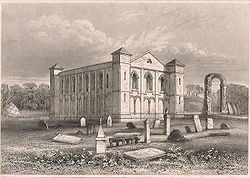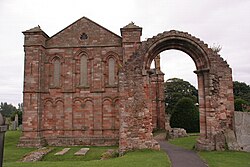Coldingham Priory
| Coldingham Priory | |
|
Berwickshire | |
|---|---|
 Coldingham Priory c1850 | |
| Location | |
| Order: | Benedictine |
| History | |
| Established: | c. 1139 |
| Mother house: | Durham Priory; Dunfermline Abbey from 1378 |
| Founder: | King David I |
| Dissolved: | 1606 |
| Information | |
Coldingham Priory was a house of Benedictine monks, the ruins of which stand on the south-east coast of Berwickshire, in the village of Coldingham.
The Priory was founded by St Æbbe at some time around AD 640, and Bede records it as one of the great monasteries of northern England in his Ecclesiastical History of the English People. Æbba's foundation declined however and the abbey was refounded by David I of Scotland, although his elder brother and predecessor King Edgar of Scotland had granted the land of Coldingham to the Church of Durham in 1098, and a church was built by him and presented in 1100. The first Prior of Coldingham of new foundation is on record by the year 1147, although it is likely that the foundation was much earlier.
The monastery was closed in 1606 and its building were largely destroyed by Oliver Cromwell in 1650,[1] some remains of the priory exist, the choir of which forms the present parish church of Coldingham, within the Church of Scotland.
Early Middle Ages
St Æbbe the Elder
According to legend, Æbbe was born aound the year 615, the daughter of the pagan King Æthelfrith of the Bernicians (who became the first King of the Northumbrian from c. 604) and Acha, a daughter of Ælla King of the of Deirans. After her father was defeated and slain by Rædwald of the East Anglians, Æbbe and her brothers fled into exile and converted to Christianity at the court of Eochaid Buide of Dalriada.
Æbbe's brother, Oswald, reconquered Northumbria in 635 and introduced Christianity in the Iona tradition.

At this time, Æbbe founded a monastery at Ebchester, then at what Bede refers to as Urbs Coludi (or in Old Engish Coldingaham). The abbey was sited on what is now called 'Kirk-Hill', but commonly called 'the Brugh', on the headland at present day St Abbs, separated from the world by a deep trench and a high palisade. This religious house lasted for about 40 years and was a double monastery of both monks and nuns governed by Æbbe.
Around 660, St Æthelthryth, Queen of Æbbe's nephew, Ecgfrith of Northumbria, came to Coldingham and became a nun.[1] She later founded the monastery at Ely. St Cuthbert arrived at Coldingham in 661 to instruct the community.
The abbey at Coldingham burnt down in 679[1] soon after Æbbe's death and was rebuilt.[1]
All that remains today at the Kirk-hill is the trench, a few grassy mounds and the ruin of a 14th-century church erected by monks of the later priory. There are few references to the house at Coldingham from its destruction until its revival in the 11th century, excepting tales of a later superior also called Æbbe. It is likely that the house was reformed as community of nuns at some point in the 8th or 9th centuries, as by the formation of the Benedictine priory in 1100 there was a thriving cult of St Æbbe at the site. The house appears to have moved from its original site at St Abb's Head to its present location around this time.
The legend of the Abbey tells of another saintly abbess known as Æbbe the Younger, who had the nuns mutilate themselves to avoid being raped by Vikings. There is no historical evidence of the incident nor of this later Æbbe's existence.
Founding of the Priory Church
In 1097, Edgar, son of King Malcolm III seized the throne of Scotland from his uncle Domnall Bán. According to a charter of 1095, Edgar was given the "land of Lothian" by the English king before securing possession of Scotland. Having secured the kingdom, King Edgar, in 1098, confirmed possession of the lands of Coldingham by the monks of Durham, and attended the consecration of the new church to St Mary in 1100. In the following years the brethren of Coldingham were to gain many charters of land, so that within fifty years they were able to assume the dignity of a Priory.
The Priory
The Priory became the caput for the Barony of Coldingham, the Prior being the feudal lord. On 2 January 1392 Sir Robert de Lawedre of The Bass was a witness to a Royal Charter to the Priory of Coldingham confirming them in all of their ancient possessions, and signed at Linlithgow.[2]
Reformation and the end of Monasticism
Following the century of the Reformation the Barony of Coldingham, previously the possession of the Priory, was erected as a temporal lordship, under the Great Seal, dated 16 October 1621, upon John Stewart, second son of Francis Stewart, 1st Earl of Bothwell, who was the last Commendator of Coldingham Priory. He personally received from the Crown a charter dated 19 October 1621, of the lands and baronies belonging to the Priory, united into one barony. Feu charters in the hands of many of the small proprietors in the neighbourhood were originally granted by him, either as Commendator or Lord. John Stewart disponed these lands and the barony on 16 June 1622 to Francis Stewart, eldest son of the Earl.
Negotiations subsequently took place between the Earl of Home and the Stewarts for the Earl's acquisition of the Barony and its possessions. These apparently failed through the Earl's inability to provide the purchase price.[3]
It is an interesting reflection on feudal superiors to note that in a petition to King Charles I dated 4 April 1636 the feuars and tenants still refer to themselves as "the vassals of the Abbacy of Coldingham". In this petition the vassals plead the oppression of the Stewarts and ask for the King to become the only superior Lord of Coldingham.[4]
In Cromwell's time the Homes of Renton seem to have taken the barony of Coldingham from the Stewarts in lieu of debt, as Harry Home, natural son of John Home of Renton apprised the barony and its lands on 26 November 1656 from Robert Stewart, lawful son of the now deceased Francis Stewart. Harry Home subsequently assigned his right to Alexander Home, eldest lawful son of said John Home of Renton, the Precept by Oliver Cromwell being dated at Edinburgh, 10 August 1658.[5]
In 1857 there were about 70 'heritors' or feuholders in the barony.[6]
Today

Today Coldingham's parish church, in the Church of Scotland, is within the restored choir of the Priory, and this church includes remnants of a 13th-century building. Coldingham Priory is the only major mediæval church in the Church of Scotland in Berwickshire or its neighbouring shires to continue in use as an active church.
Outside of the church building the ruins were in a very poor state, badly eroded, overgrown and at risk of collapse. But with the help of the Heritage Lottery Fund the site has been rejuvenated: the ruins conserved, footpaths reinstated and a wasteland transformed into a community garden with a monastic theme, concentrating on plants with culinary, medicinal, and aromatic properties. There are also interpretation boards, explaining the hundreds of years of history contained within its walls, while a year-long education programme engaged schools and community groups in many diverse activities relating to the Priory and its conservation.
References
| ("Wikimedia Commons" has material about Coldingham Priory) |
- ↑ 1.0 1.1 1.2 1.3 "History of Coldingham": Coldingham Village History
- ↑ The Great Seal of Scotland, confirmed 16 March 1391/2, number 839
- ↑ Historic Manuscripts Commission, Manuscripts of Colonel David Milne-Home of Wedderburn Castle, N.B., London, 1902: 13, 197-199
- ↑ Historic Manuscripts Commission, Manuscripts of Colonel David Milne-Home of Wedderburn Castle, N.B., London, 1902: 201 - 202
- ↑ Historic Manuscripts Commission, Manuscripts of Colonel David Milne-Home of Wedderburn Castle, N.B., London, 1902: 13, and 202-4
- ↑ Hunter, William King, History of the Priory of Coldingham, Edinburgh & London, 1858